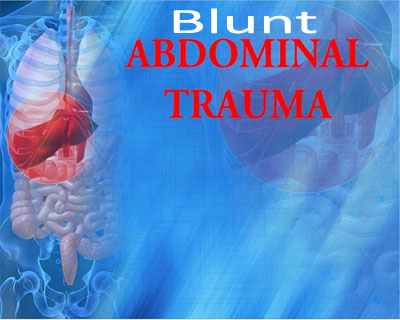- Home
- Editorial
- News
- Practice Guidelines
- Anesthesiology Guidelines
- Cancer Guidelines
- Cardiac Sciences Guidelines
- Critical Care Guidelines
- Dentistry Guidelines
- Dermatology Guidelines
- Diabetes and Endo Guidelines
- Diagnostics Guidelines
- ENT Guidelines
- Featured Practice Guidelines
- Gastroenterology Guidelines
- Geriatrics Guidelines
- Medicine Guidelines
- Nephrology Guidelines
- Neurosciences Guidelines
- Obs and Gynae Guidelines
- Ophthalmology Guidelines
- Orthopaedics Guidelines
- Paediatrics Guidelines
- Psychiatry Guidelines
- Pulmonology Guidelines
- Radiology Guidelines
- Surgery Guidelines
- Urology Guidelines
Standard Treatment Guidelines for Blunt Abdominal Trauma

Blunt abdominal trauma (BAT) is an increasingly common problem encountered in the emergency department. The usual causes of BAT include vehicular accident, assault, falls, sports injuries and natural disasters.
The Ministry of Health and Family Welfare has issued the standard treatment General Surgery Guidelines for Blunt Abdominal Trauma. Following are the major recommendations:
Case definition:
BAT is suspected in any patient involved in above situations and presents with abdominal pain, distention or shock. It should be looked for in patients of polytrauma.
One study has reported 2.1% incidence of BAT amongst all surgical patients admitted to a tertiary hospital during 1 year.
Differential diagnosis:
Abdominal trauma forms a differential diagnosis of any patient presenting with acute abdomen.
Use of appropriate safety measures during various activities associated with BAT can significantly reduce its incidence.
Clinical diagnosis: This is based on
Investigations:
Treatment (Standard operating procedure):
In patient:
Referral criteria:
After Damage Control Surgery if the local facilities are inadequate.
Clinical diagnosis: This is based on
Investigations:
Who does what and timelines:
Doctor:
Does initial evaluation, subsequent monitoring, decision regarding investigations and therapeutic intervention.
Nurse:
Assists in resuscitation, monitoring, investigation and treatment.
Technician:
Assists in resuscitation, investigation and treatment
Guideline developed by Ministry of health and family Welfare-
Group Head Coordinator of Development Team Dr Ajit Sinha, Department of Surgery Safdarjung Hospital New Delhi
The Ministry of Health and Family Welfare has issued the standard treatment General Surgery Guidelines for Blunt Abdominal Trauma. Following are the major recommendations:
Case definition:
BAT is suspected in any patient involved in above situations and presents with abdominal pain, distention or shock. It should be looked for in patients of polytrauma.
Incidence of the condition in our country
One study has reported 2.1% incidence of BAT amongst all surgical patients admitted to a tertiary hospital during 1 year.
Differential diagnosis:
Abdominal trauma forms a differential diagnosis of any patient presenting with acute abdomen.
Prevention and counseling
Use of appropriate safety measures during various activities associated with BAT can significantly reduce its incidence.
Optimal diagnostic criteria, investigations, treatment and referral criteria
At Secondary Hospital
Clinical diagnosis: This is based on
- High level of suspicion of intra-abdominal injury
- Presence of wounds/ bruising on the abdomen
- Abdominal guarding/ tenderness
- Presence of free gas/ fluid in the peritoneal cavity
- Presence of fracture of lower ribs and/ or pelvis increases the likelihood of intraabdominal injury
- Note should be made of altered mental state, drug or alcohol intoxication and distracting injuries which may mask the features of BAT
- Repeated examination increases the accuracy of diagnosis
Investigations:
- All hemodynamically stable patients with suspected BAT should undergo Focused Abdominal Sonography in Trauma (FAST)or Diagnostic Peritoneal Lavage (DPL)
- Urgent laparotomy is indicated in patients with evidence of BAT who remain hemodynamically unstable despite initial resuscitation
Treatment (Standard operating procedure):
In patient:
- All patients should have initial cervical stabilization and resuscitation, if required
- Initial fluid resuscitation should be done with 2L warmed Ringer Lactate solution infusedrapidly through 2 peripheral lines
- A nasogastric tube and a Foley catheter should be put
- Laparotomy should be done, if indicated on the basis of clinical features, FASTor DPL
- Laparotomy should be done through a long midline incision
- Bleeding should be controlled by clamping/ packing till definitive control is possible
- Hollow viscus should be repaired
- In case the intra-abdominal injuries are extensive, patient is very sick and OT facilities/ surgeon’s experience is suboptimal, Damage Control Surgery may be done. Definitive surgery should be done subsequently under improved circumstances or at a higher center.
Referral criteria:
After Damage Control Surgery if the local facilities are inadequate.
At Super specialty Hospital
Clinical diagnosis: This is based on
- High level of suspicion of intra-abdominal injury
- Presence of wounds/ bruising on the abdomen
- Abdominal guarding/ tenderness
- Presence of free gas/ fluid in the peritoneal cavity
- Presence of fracture of lower ribs and/ or pelvis increases the likelihood of intraabdominal injury
- Note should be made of altered mental state, drug or alcohol intoxication and distracting injuries which may mask the features of BAT
- Repeated examination increases the accuracy of diagnosis
Investigations:
- All hemodynamically stable patients with suspected BAT should undergo Focused Abdominal Sonography in Trauma (FAST)or Diagnostic Peritoneal Lavage (DPL)
- In case the intra-abdominal injuries are extensive, patient is very sick and surgeon’s experience is suboptimal, Damage Control Surgery may be done. Definitive surgery should be done subsequently under improved circumstances
- Angiography and angioembolization may be considered in hemodynamically stable patients with solid organ injury who are suitable for non-operative management
Who does what and timelines:
Doctor:
Does initial evaluation, subsequent monitoring, decision regarding investigations and therapeutic intervention.
Nurse:
Assists in resuscitation, monitoring, investigation and treatment.
Technician:
Assists in resuscitation, investigation and treatment
Guideline developed by Ministry of health and family Welfare-
Group Head Coordinator of Development Team Dr Ajit Sinha, Department of Surgery Safdarjung Hospital New Delhi
Blunt abdominal traumaDr Ajit SinhaGeneral Surgery GuidelinesguidelinesMinistry of Health and Family WelfareStandard Treatment Guidelines
Next Story
NO DATA FOUND

Disclaimer: This site is primarily intended for healthcare professionals. Any content/information on this website does not replace the advice of medical and/or health professionals and should not be construed as medical/diagnostic advice/endorsement or prescription. Use of this site is subject to our terms of use, privacy policy, advertisement policy. © 2020 Minerva Medical Treatment Pvt Ltd